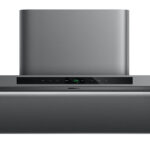If you work with metal in a home garage or small shop, you probably know three frustrations: warped thin panels, long hours of grinding, and a steep learning curve that keeps you guarding the torch. As hand held laser technology spreads, a hand held laser welder lets you tackle those same jobs with cleaner results and far less stress.
Choosing a Welding Partner
Before you bring a laser into your workflow, ask who built it. A dedicated laser welding manufacturer, such as Denaliweld, designs machines specifically for welding, not as reworked general tools. Hence, a hand held laser welder from this kind of specialist is more likely to strike a balance among power, control, and safety.

How Laser Welders Change Projects
Hand held laser welding began in high-end manufacturing, but it now fits comfortably in small shops and serious DIY spaces. Instead of relying solely on MIG or TIG, you can reach for a hand held laser welder when thin sheet metal, detailed joints, or heat-sensitive parts make traditional methods feel risky.
From Factory Tool to Workbench
Older laser setups were large, fixed systems with dedicated rooms. Modern portable units pack the laser source, cooling, and controls into a compact cabinet you can roll between jobs, while the handpiece feels like a slightly heavier MIG gun that moves easily around the work.
Core Hand held Laser Welder Capabilities
At the core of hand held laser welding is a concentrated beam that fuses metal through a very small heat-affected zone. A hand held laser welder sends energy only where you point it, helping you keep distortion low and welds noticeably cleaner than many arc processes.
How Laser Welding Differs
With MIG and TIG, you usually feed filler wire into an arc to bridge the joint. Laser welding often lets you join parts without filler, provided fit-up is good, creating a smaller, cleaner puddle that works well in tight spaces and can be much faster on thin material.
Speed, Precision, and Heat Control
The narrow beam lets you place precise beads along corners, seams, and complex curves without soaking the whole part in heat. On thin stainless, aluminum, or mild steel, this can be the difference between a panel that stays flat and one that ripples as it cools.
Software and Parameter Controls
Modern hand held units include software that lets you tune power, pulse behavior, and beam pattern, then store presets for recurring jobs. Instead of guessing, you test a setting on scrap, save it, and recall it later for parts made from the same material and thickness.
Portability for DIY and Mobile Work
Physical Design and Ergonomics
Compact power cabinets and lightweight cables make it realistic to wheel the machine around your shop or job site. A well-balanced handpiece reduces fatigue when you follow long seams or reach into door frames, racks, and chassis rails.
Operating Environments
Quality hand held systems are designed to run in typical workshop conditions over a broad temperature range. You still need to protect the unit from impact, dust, and moisture, but you do not have to treat it like fragile lab equipment so that it can work near vehicles and machinery.
Flexibility Across Materials and Joints
You can use hand held lasers on many common metals, including carbon and stainless steels and aluminum alloys, as long as the material and thickness fall within the machine’s rating. Lap joints, fillets, corners, and butt joints all benefit from a smaller, more focused weld pool.
Advantages of DIY Metal Projects
Reduced Distortion and Cleanup
Because the heat-affected zone is small, the surrounding metal expands and contracts less, so parts tend to retain their original shape. Visible surfaces show less discoloration, and you often spend far less time straightening, filling, and grinding before paint or final finish.
Shorter Learning Curve
Learning any welding process takes effort, but controlling a laser torch can feel straightforward once you understand basic movement and speed. That makes it easier to bring newer team members up to a usable skill level than with processes that demand very fine puddle control.
Lower Maintenance and Consumables
These systems do not burn through contact tips and filler wire the way many arc setups do. Routine care usually focuses on clean optics, solid electrical connections, and proper cooling, which can reduce day-to-day consumable costs and unplanned downtime throughout the machine’s life.
Cost and Access Considerations
Even an entry-level hand held laser represents a serious purchase, especially compared with a basic MIG machine. To judge value, compare the price to what you currently spend on rework, grinding discs, outsourced precision welding, and labor lost to slow or distorted welds.

Safety in DIY and Small Shops
Laser and Welding Safety
A hand held laser may look like a simple torch, but the beam is powerful enough to cause permanent eye and skin injury. You need appropriate eye protection, gloves, clothing, and a rule that no one enters the welding area without understanding how the system works.
Workspace Setup for Laser Welding
Treat the weld zone as a controlled area. Shield reflective surfaces, manage cables to avoid trips, provide ventilation for fumes, and add simple barriers or curtains where needed. A short pre-weld checklist helps you catch problems before you power up the machine.
Reliability, Certification, and Inspection
When you shop for a hand held system, reliability should matter as much as power. A manufacturer such as Denaliweld combines quality components with documented certifications, so you can see how the equipment was tested. Whatever brand you choose, follow its inspection and maintenance schedule to maintain consistent performance.
Surprising DIY Laser Welding Projects
Once you understand the basics, hand held laser welding opens up projects that would be awkward or slow with other methods, from delicate repairs to visible feature welds.
Automotive Body and Custom Parts
For automotive work, laser welding excels on thin body panels, brackets, and custom parts that must stay straight. You can stitch in patch panels, fabricate mounts, and refine exhaust components with cleaner beads and less heat damage to surrounding paint or trim.
Lightweight, High-Strength Structures
If you build racks, frames, or supports, the combination of narrow, strong beads and low distortion lets you keep designs light while still resisting real-world loads on vehicles, trailers, or workshop equipment.
Electronics and Instrument Enclosures
Small enclosures and instrument housings benefit from neat, low-heat welds. You can join thin stainless or aluminum cases with minimal discoloration, preserving precise dimensions so lids, gaskets, and connectors still line up after the welds cool.
Custom Fabrication, Fixtures, and Jigs
In a fabrication setting, fixtures and jigs set the accuracy of many jobs. Laser welding helps you build these tools with little distortion, so locating holes and reference edges stay where you designed them, and later adjustments add features without heavily reheating the whole structure.
Mixed-Material Repairs and Modifications
Some hand held laser systems can handle certain combinations of dissimilar metals within their limits. Controlled heat input makes it more realistic to reinforce or repair assemblies made from different alloys, extending the life of parts you might otherwise scrap.
Decorative Metal Art and Welds
For decorative pieces, the weld can become part of the look instead of something to hide. Narrow, smooth laser beads can stand out as clean lines on railings, sculptures, or furniture, reducing the grinding and polishing needed to achieve a finished appearance.
Planning DIY Laser Welding Projects
Planning helps you get the most from a hand held system, whether you are building one-off pieces or short production runs.
Matching Projects to Capabilities
List the metals, thicknesses, and joint styles you use most, then compare them with each machine’s specifications for material range and duty cycle. Choosing a system with comfortable headroom makes everyday work smoother and experimentation less stressful.
Time, Training, and Workflow
Switching to laser welding affects scheduling and equipment. You will need time for training, parameter setup, and fit-up practices that match the process, but once dialed in, faster welds and less rework can shorten overall build times.
When Laser Welding Is Unsuitable
Laser welding is not ideal for every job. Very thick sections, heavily contaminated surfaces, or joints without clear access may still be better handled with other processes that offer deeper penetration or more tolerance for poor conditions.
Conclusion
Hand held laser technology now gives you a way to tackle demanding work without feeling trapped by warping panels, long cleanup, or a narrow pool of experienced welders. A hand held laser welder, paired with a trusted manufacturer such as Denaliweld and a solid safety and training plan, can turn high-quality welds into an everyday part of your DIY or small-shop workflow.







